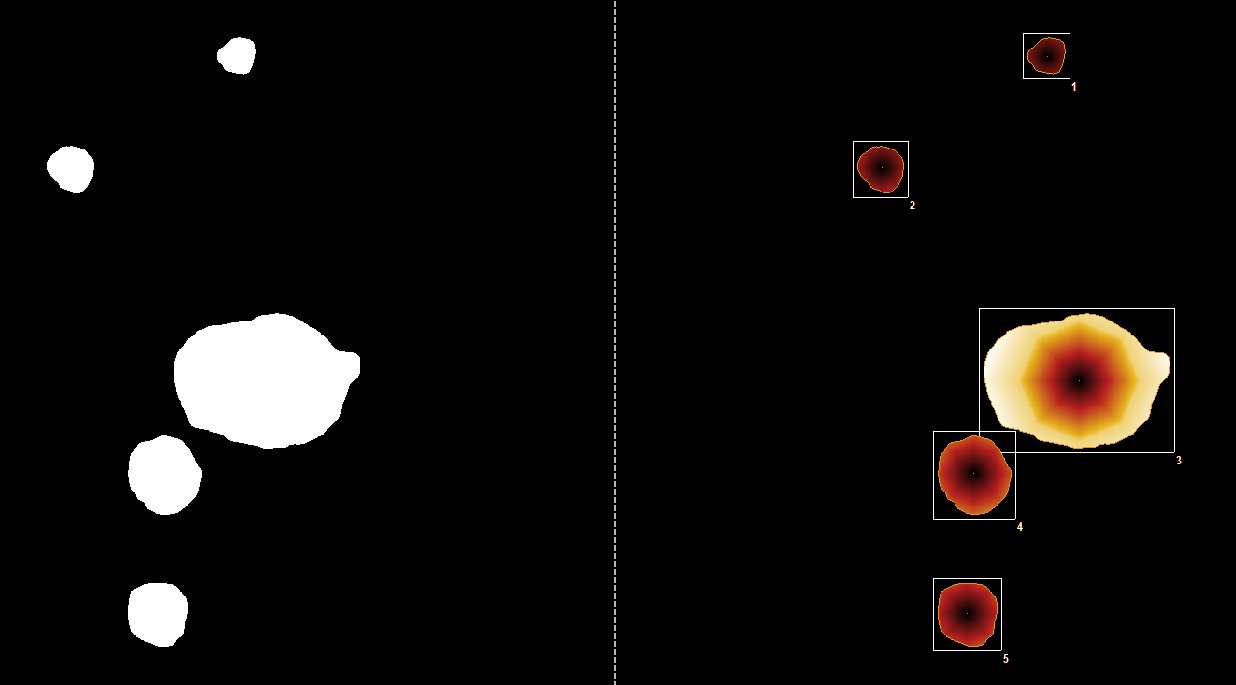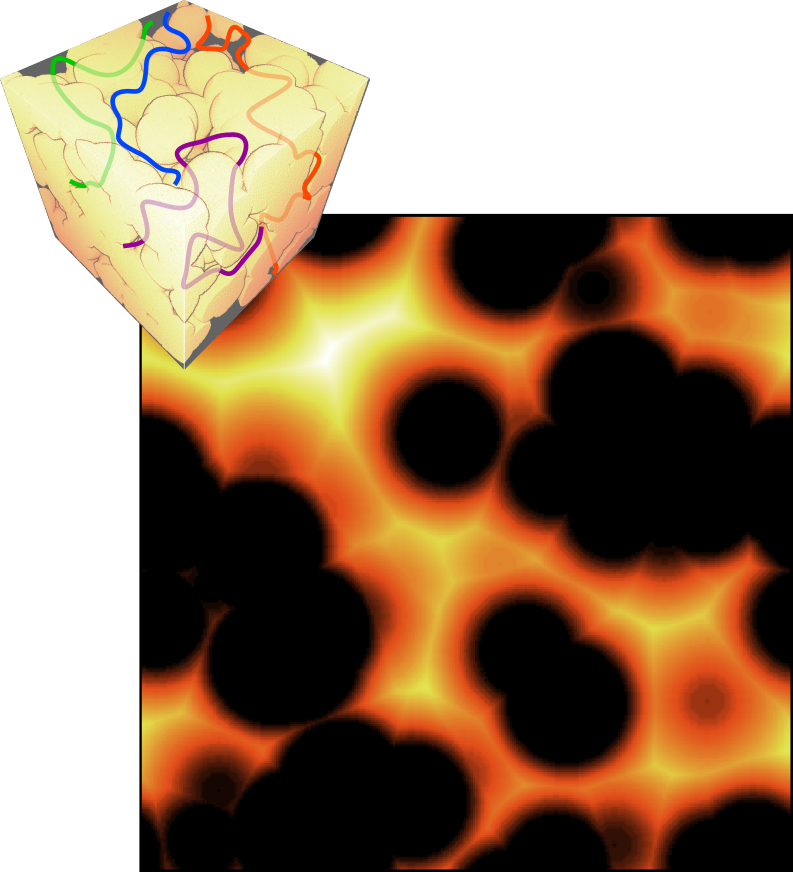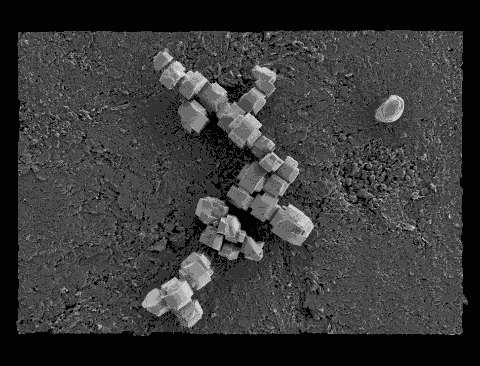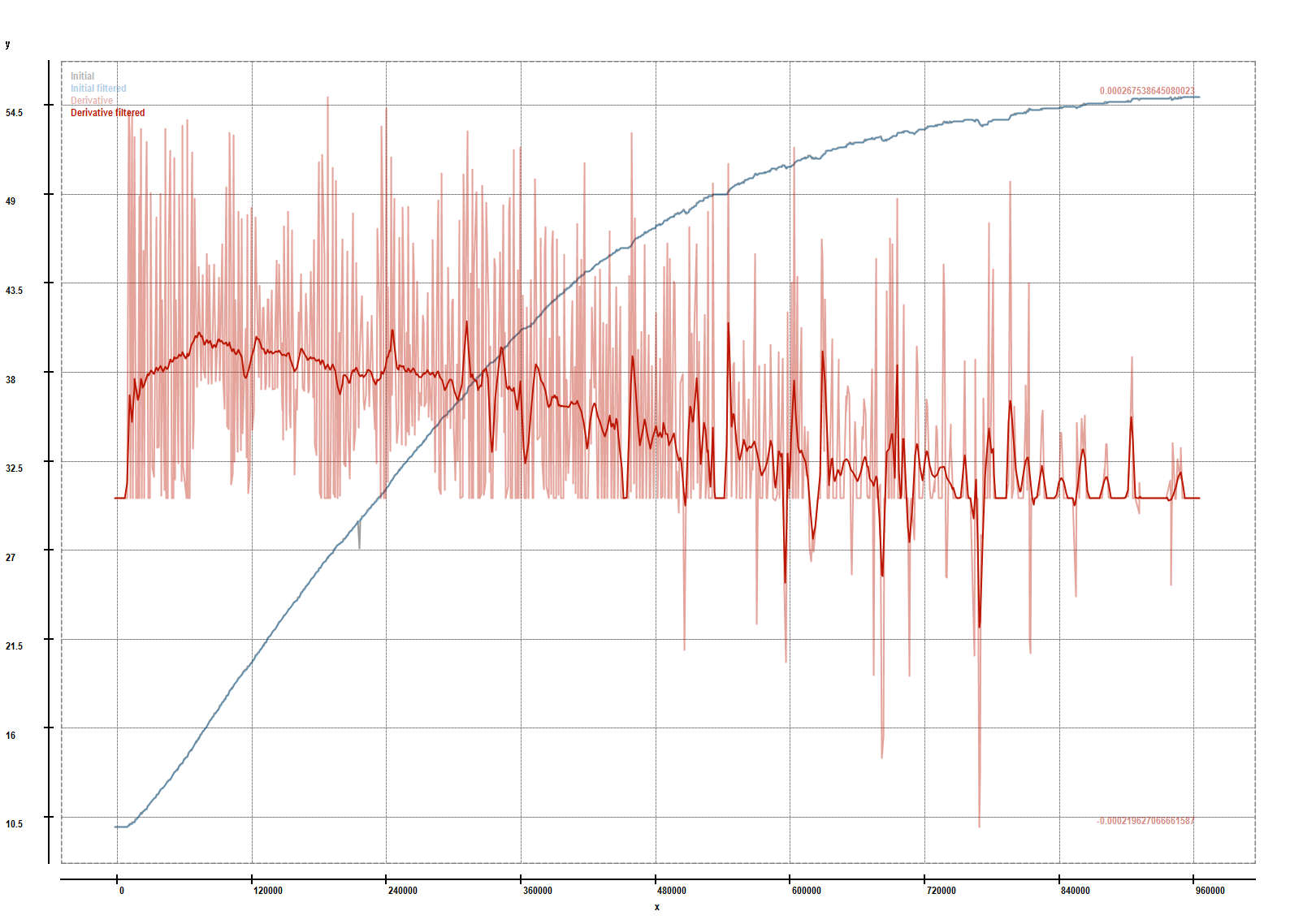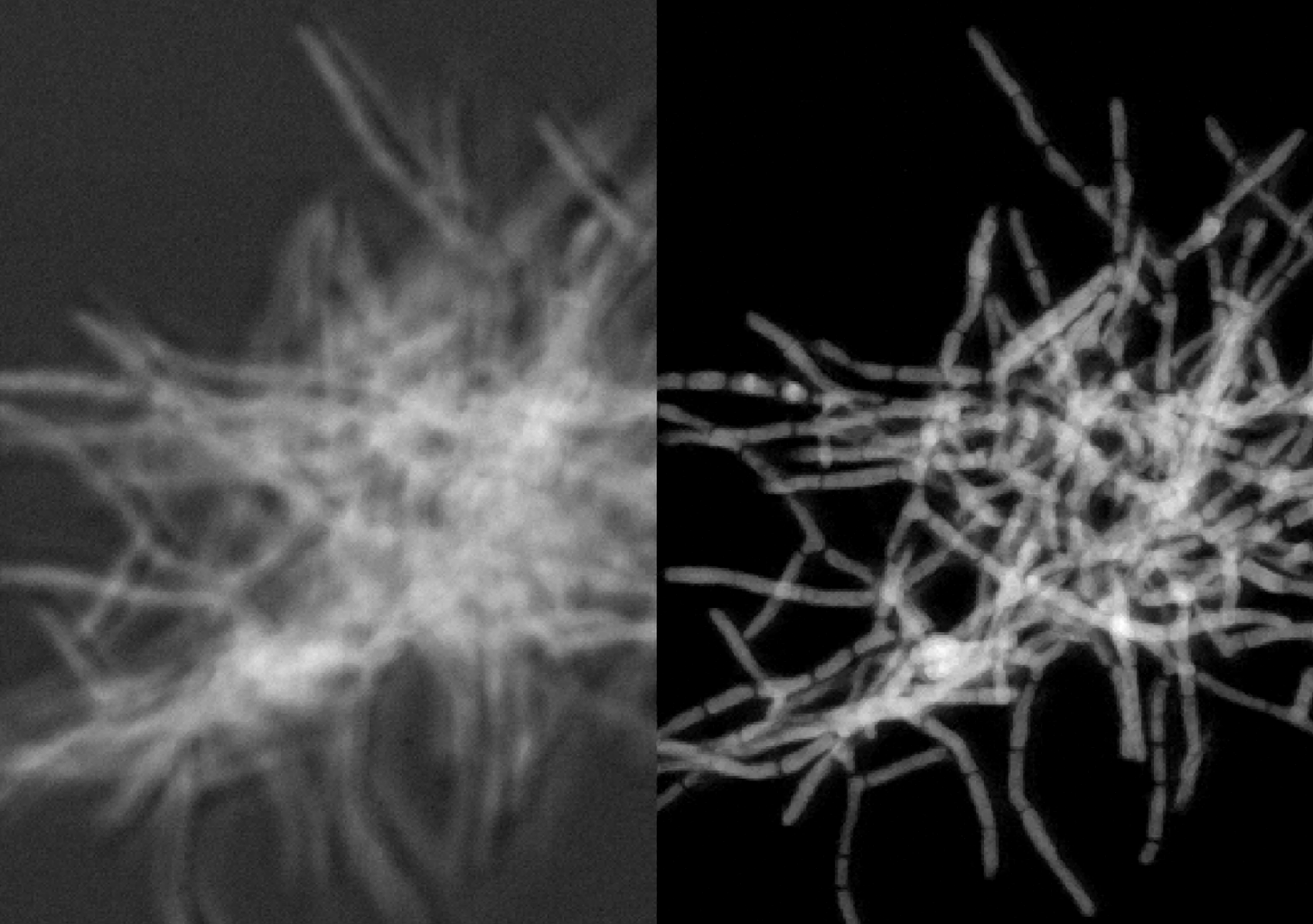Extraction of porosity
Extraction of porosity from binary image or volume taking into account external roughness. This plugin operates with a morphological closing by a disc whose radius can be automatically estimated, followed by a geodesic morphological opening. This method is defined and used in [Moreaud et al. 2008]. Update 20220413...
Extract patches from image
Extract patches from image using graphical interface. Update: 200200923: adding normalization for 8 bits or 24bits RGB image.
Rugosity analysis
Rugosity / texture analysis by H-maxima and area of influences on zones of interest drawn over the image. Computation of local maxima or minima, then area of influence, and for each area of influence, extraction of the surface area, minimum, and maximum intensity values. The zones of interest are directly defined by...
Homogenization Dielectric Permittivity FFT scheme
An efficient method to solve the problem of homogenization of physical properties of heterogeneous media, such as dielectric permittivity, is the implementation of numerical solutions, before estimating the effective properties by spatial average of the solution. The input data is a 3D binary volume or a 2D binary...
Get plane
Extract cut plane(s) of a volume. Update 20210223: add atlas extraction and extraction of all cut planes along one axis can be saved in TIFF or PNG format. Update 20200423: extraction of all cut planes along one axis.
Histogram 2D/3D
Compute the histogram of an image or a volume. Updates 20230711: Support for unsigned char, integer, float, double types. Support for volume format.
ARFBF Morphological Analysis
In the case of active phases observable in the form of stacked sheets, the classic strategy is to segment these sheets individually and characterize their length or curvature [Celse, 2008], which may related to actibity [Gandubert, 2006]. Since the images are quite noisy at this level of resolution, this type of...
Mathematical morphology binary geodesic operations 2D and 3D
Mathematical morphology has been introduced by Matheron and Serra [Serra, 1982] in the late 1960's. It defines among others, two basic operators: dilation and erosion. These tools and their combinations are powerful and widespread for filtering and image analysis. For instance, operations such as opening, closing are...
Workshop GdR NanOperando 2019
A workshop dedicating to the potential of plug im! platform to extract quantitative information from data from in situ experiments, therefore "dynamic" by nature! Includes a package with a set of plug im! modules, working data files, and pdf slides to guide users.
Luminosity drift correction by morphological approach
Luminosity drift correction by TopHat operation combined with smoothing filter and / or LIP substraction.
Criterion opening
Opening by criterion, usually referred to as attribute opening (Breen & Jones, 1996; Serra, 1988; Walter, 2003; Salembier et al., 1998) is a class of more general connected filters (Salembier&Wilkinson, 2009). In binary context, this operation is a filter on the set of the connected components (CC) based on criterion...
Image sequence analysis of binary objects
Calculates the morphological analysis and movement of binary objects in an image sequence. Each object is individually tracked over the entire image sequence. The input data must be a 3D volume, each plane on the Z axis corresponding to an image of the image sequence. Morphological characterization : surface area, ...
SAXS for Boolean models of spheres
This plugin computes the scattering intensity from the analytical covariance of multiscale models built from union and intersection of Boolean models of spheres with Gamma or lognormal radius distributions. Another numerical approach, using projections of realisations for any kind of models, can be find in Sorbier et...
CPE Lyon Morphological Random Models : introduction, course, 2019
CPE Lyon Morphological Random Models : introduction, course, 2019
Extraction of connected components in individual files, 2D and 3D
Extract, separate and save connected components in individual images/volumes in a directory. Update 20230227 : added support of 3D volumes. Update 20190909 : fixed save individual images. Update 20191004 : fixed save individual images.
Closing ends
Considering edges of connected components as ends, each end pixel is linked to another end pixels if the two pixels belong to different connected components, and if the distance between the two pixels is less than a threshold. This operation can be useful in the case of disconnected filamentous objects and it is used...
Skeleton by thinning
This plugin performs a skeleton computation by thinning algorithm. Topological thinning consists in gradually removing the points of the contour of the shape, while preserving its topological characteristics. If you use this plugin, please cite : Y.Y. Zhang ; P.S.P. Wang, A modified parallel thinning algorithm,...
M-tortuosity-by-iterative-erosions
M-tortuosity-by-iterative-erosions for the characterization of 2D images and 3D volumes: Computation of the M-tortuosity estimator of the microstructure, as seen by a spherical particle of given size. In addition to keeping the properties of the M-tortuosity, this descriptor is linked to the notion of constrictivity,...
M-tortuosity
Computation of the M-tortuosity estimator for the characterization of 2D images and 3D volumes: a scalable topological descriptor providing a 3D map of mean tortuosities, a set of M-coefficients, of which the histogram is meaningful, and a final scalar value, the M-scalar, assessing the geometric tortuosity of the...
Local orientation estimation
Fast and robust method to estimate local orientations from the covariance matrix of the gradient. The estimation of the local orientation requires to define a size of neighbourhood around each pixel that contain several oriented objects. If you use this plugin, please cite : D. Jeulin, M. Moreaud. Segmentation of...
Flowing bilateral filter
The bilateral filter plays a key role in image processing applications due to its intuitive parameterization and its high quality filter result, smoothing homogeneous regions while preserving the edges of the objects. Considering the image as a topological relief, seeing pixel intensities as peaks and valleys, we...
Stereo reconstruction with Top-Down Segmented Regression
TDSR (Top-Down Segmented Regression) provides a stereo reconstruction method able to estimate the topography from SEM images. Standard stereo methods fail to evaluate adequate 3D reconstructions because of the homogeneous surface of these samples. The main approach of TDSR is to combine existing stereo methods with...
Thickness analysis
Compute the thickness of the largest connected component of an image using distance functions and a watershed operator. As a result, this plugin provides a report in text format indicating the average, minimum, maximum and standard deviation of this thickness. Update 20210504 : analysis of the largest connected...
Separation of binary objects
This plugin performs a separation of fusionned/linked binary objects with standard approch from mathematical morphology i.e. using operators such as opening, distance transform, h-maxima, and watershed. For more explanations, look at Serge Beucher (PSL Mines ParisTech, CMM) courses, and take opportunity to read his...
Robust derivative of a signal
Compute robust derivative of a signal using self-adapting filtering. This plugins applies a filter on the initial data, compute the derivative, and can also applies a post filtering on the obtained derivative. The self-adapting filtering is based on the algorithm used on signal auto smoothing plugin.
Histogram under mask
Compute the gray level histogram for the zones defined by a mask. The zones are directly defined by drawing on the image (use the help button of the plugin to know more). This plugin computes also gray levels histogram of the union of the zones.
Robust tracking of an object of interest
Robust tracking of an object on a list of images. This plugin tracks an object of interest defined by a box on a list of images, and produces overlayed boxes or registrated images. It could be used in the case of noisy or very low contrasted images like TEM HR images. This plugin was used in the context of the ANR...
Granulometry by morphological opening by disks
Morphological opening granulometry with increasing radius disks for binary images.
3D volume from images list
Create a 3D volume from images listed in a directory. Simply load one of the images of the directory. Images should be in FDA, BMP, JPEG or TIFF format. Images are taken in alphabetical order. The result is a 3D volume. Update 20211029 : support for FDA format. Update 20191118 : support for BMP and JPEG images...
FACE : Fast mean Absolute difference with Confidence propagation for Extended depth of field
Bright field microscopes with low depth of field provide good magnification and image quality. However, samples generally have a thickness greater than the depth of field, thus being not entirely observable within the viewing distances intervals and preventing the creation of sharp images. It is possible to gradually...

